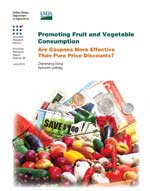Promoting Fruit and Vegetable Consumption: Are Coupons More Effective than Pure Price Discounts?
- by Diansheng Dong and Ephraim Leibtag
- 6/3/2010
Overview
The U.S. Department of Agriculture administers food and nutrition assistance programs that promote fruit and vegetable consumption. But consumption remains relatively low among program recipients as well as among the general U.S. population. The perceived high cost of produce is often cited as a deterrent to more consumption. This study looks at coupons and price discounts, two methods of lowering the cost of fruits and vegetables, and uses household purchase data and a consumer demand model to examine each method. Coupons influence consumer behavior through a price-discount effect and an informational/advertising effect. Because of this dual effect, the use of a coupon to increase fruit and vegetable purchases may be more effective than a pure price-discount policy or other noncoupon promotion. Assuming a coupon usage rate of 10 to 50 percent, lowering prices through a "10 percent off" coupon would increase average weekly fruit and vegetable quantities purchased by 2 to 11 percent, as compared with a 5- to 6-percent effect for a pure price discount.
Download
-
Entire report
Download PDF -
Report summary
Download PDF -
Download ERR96.zip
Download ZIP


